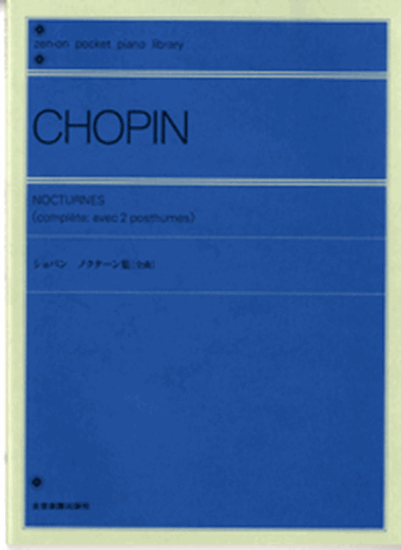Chopin, Frederic : Nocturne No.16 Es-Dur Op.55-2
Work Overview
Genre:nocturne
Total Playing Time:4 min 30 sec
Copyright:Public Domain
Commentary (2)
Author : Ooi, Kazurou
Last Updated: July 21, 2018
[Open]
Author : Ooi, Kazurou
Analysis of Melodic Lines
This Nocturne is characterized by a particularly high number of melodic notes, featuring many ornamental figures. Consequently, it can be a challenging Nocturne to comprehend musically. However, by analyzing and grasping the melodic lines, it becomes significantly easier to play. While various analytical approaches exist, the author has attempted an analysis based on five thematic materials, two cadential forms, a three-measure sequence, and a Coda. The following discussion pertains exclusively to the melodic lines and does not include the accompaniment.
- A: From measure 1 to the E-flat on beat 3 of measure 4.
- B: From beat 4 of measure 4, ending on G on beat 2 of measure 8.
- A': From the A-flat on beat 3 of measure 8 to the E-flat on beat 4 of measure 12.
- C: From measure 13 to measure 18.
- D: From measure 19 to beat 3 of measure 26.
- E: From beat 4 of measure 26 to beat 2, or beat 3, or beat 4 of measure 30.
- Sequence: From measure 31 to the E-flat on beat 1 of measure 34.
- A'': From beat 2 of measure 34 to beat 4 of measure 38.
- C': From the anacrusis of measure 39 to the end of measure 44.
- First Cadential Form: From measure 45 to beat 1 of measure 47.
- C'': From the upbeat of beat 2 of measure 47 to the end of measure 52.
- Second Cadential Form: From measure 53 to the end of measure 55.
- CODA: From measure 56 to the end.
It becomes clearer when focusing only on the essential notes. While this is merely one possible analysis, such an approach can facilitate understanding and construction of the piece. For your reference.
Author : Ueda, Yasushi
Last Updated: January 1, 2010
[Open]
Author : Ueda, Yasushi
Deux Nocturnes Op.55
These two nocturnes were composed in 1843, and their first editions were published in Paris (M. Schlesinger, 1844), Leipzig (Breitkopf und Härtel, 1844), and London (Wessel, 1859). J. W. Stirling (1804-1859), to whom the pieces were dedicated, was a student of Chopin, an ardent admirer of her teacher, and harbored romantic feelings for him. Born into a wealthy Scottish family, she assisted Chopin in various ways from the time she met him in Paris until her death. Although her excessive kindness often troubled Chopin, he maintained a courteous demeanor towards this good-hearted woman. The Chopin memorabilia and documentary records she collected have become important resources for Chopin studies. These works are believed to have been composed around the time the two met.
These nocturnes clearly demonstrate an interest not only in the vocal style of contemporary opera arias but also in Baroque style, particularly contrapuntal writing. Chopin rarely applied counterpoint strictly in his own compositions, with the exception of the two-part fugues written as studies, but these two pieces reveal his yearning for counterpoint. Nevertheless, he had studied counterpoint diligently since his time in Poland, and in Paris, he resumed his studies in 1841 with Luigi Cherubini's textbook Cours de contrepoint et de fugue (Treatise on Counterpoint and Fugue), Cherubini being the director of the Paris Conservatoire and an authority on counterpoint.
No. 2 in E-flat Major
The second piece can be divided into the following three sections:
- Measures 1–26 (hereinafter A), where two themes are presented
- Measures 26–34 (hereinafter B)
- Measures 35–55 (hereinafter A’), as a recapitulation and development of A
- And the coda (measures 56–67)
The presentation of two themes in different keys seems to be conscious of sonata form, and this is the most characteristic feature of this nocturne. Furthermore, similar to No. 1, the contrapuntal treatment of the right hand is noteworthy.
Section A, like many of Chopin's works, begins on the dominant (B-flat in this piece). However, the opening chord in the left hand is not the tonic chord but the dominant chord, which immediately resolves to the tonic chord in measure 2. This is why the piece sounds as if it begins abruptly, as if from the middle. In this nocturne, two musical ideas are prepared in the main section: one in measures 1–12 (hereinafter a), and another in measures 13–26 (hereinafter b). The first theme melody of section 'a' is repeated twice. In his nocturnes, Chopin invariably varies melodies when repeating them, with the usual method being melodic ornamentation. However, here he employs a new variation method. At the beginning of the piece, the right hand plays a single melody, but in the repetition starting at measure 9, he adds a new voice in the inner part, introducing a change. The melody of 'a' reappears in A', but here the melody is chromatically ornamented, and a strongly assertive sixteenth-note counter-melody is added in the middle voice.
The same can be said for the second theme 'b', presented in the subdominant major, A-flat major. Section 'b' is also recapitulated in the latter half of the piece, section B, and is repeated twice; in both instances, it is not merely a repetition but always features new counterpoint (measures 39–55). Thanks to these often chromatically moving counter-melodies, the vertical sonorities create a rather intricate impression for the listener.
In contrast, the coda's texture is simplified again, and the piece concludes with clear arpeggiated chords and cadences.
Arrangements & Related Works(1)
Saint-Saëns, Camille: Nocturne No.16
Total Performance Time: 4 min 20 sec
PTNA & Partner Channel Videos(6items)
Sheet Music
Scores List (13)

(株)全音楽譜出版社

(株)全音楽譜出版社

ハンナ(ショパン)

(株)ドレミ楽譜出版社

(株)音楽之友社

(株)全音楽譜出版社

(株)音楽之友社

(株)全音楽譜出版社

(株)全音楽譜出版社

(株)全音楽譜出版社

ポーランド音楽出版社

(株)ヤマハミュージックエンタテインメントホールディングス

(株)音楽之友社








